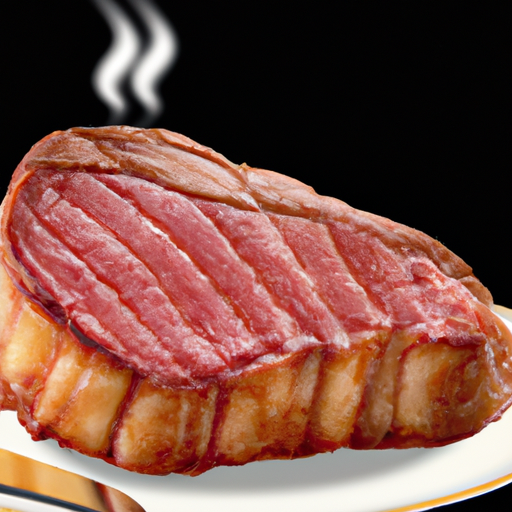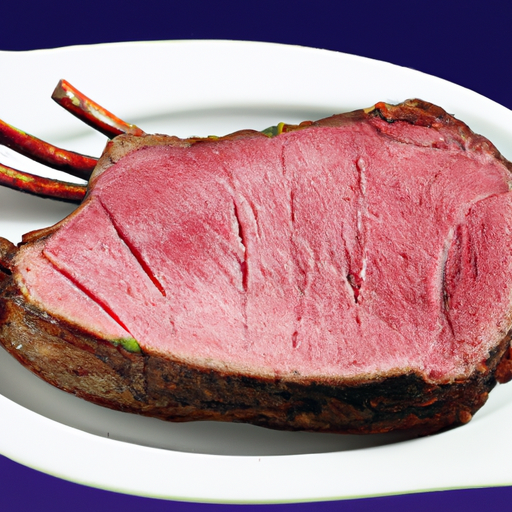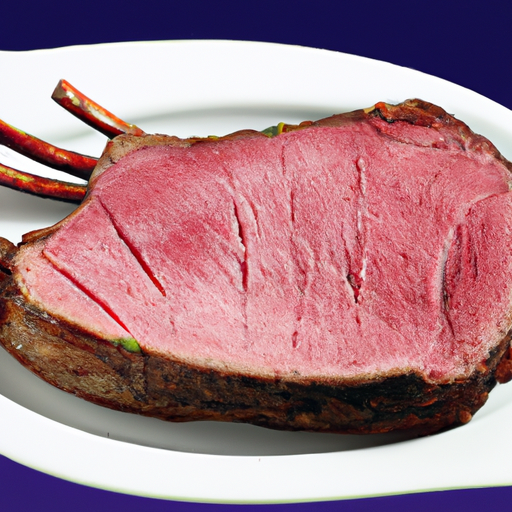Imagine effortlessly cooking the perfect prime rib every time, with tender, juicy meat that melts in your mouth. With “Perfect Prime Rib Cooking,” you can say goodbye to overcooked or undercooked prime rib forever. This incredible product provides you with a detailed cooking chart per pound, ensuring that your prime rib is cooked to perfection, just the way you like it. Say hello to your new secret weapon in the kitchen and prepare to impress your family and friends with your culinary skills.

Choosing the Right Cut of Prime Rib
When it comes to selecting the best cut of prime rib, there are a few factors to consider. The first thing to look for is a rib roast that has a good amount of marbling. Marbling refers to the visible fat streaks throughout the meat, and it plays a key role in determining the tenderness and flavor of the roast. Look for a rib roast with fine white lines of fat running through the meat, as this is a sign of a well-marbled cut.
Another important factor to consider is the grade of the meat. Prime grade rib roasts are the highest quality and offer the most tenderness and flavor. However, they can also come with a higher price tag. If budget is a concern, you can also opt for choice or select grade rib roasts, which are still delicious but may not have quite as much marbling.
Lastly, consider the bone-in versus boneless option. A bone-in rib roast, also known as a standing rib roast, is great for presentation and adds flavor to the meat. However, if you prefer ease of carving and serving, a boneless rib roast may be more suitable.
Determining the Perfect Size
When it comes to prime rib, determining the perfect size depends on the number of people you plan to serve and their appetites. As a general rule of thumb, you can estimate that each person will consume around 1/2 to 3/4 pound of prime rib. However, if you have hearty eaters or want leftovers, you might want to aim for a bit more.
To calculate the size of prime rib you need, simply multiply the number of guests by the estimated portion size. For example, if you are expecting 8 guests and each person will consume 3/4 pound of prime rib, you should aim for a roast that weighs around 6 pounds. Keep in mind that it’s always better to have a slightly larger roast than to run out of meat.
Preparing the Prime Rib
Before you even think about cooking your prime rib, there are a few important steps to take to ensure it turns out perfectly.
Trimming the Excess Fat
It’s common for prime rib roasts to come with a layer of excess fat on one side. While fat can add flavor and moisture to the meat, excessive fat can make the roast greasy and prevent the seasoning from penetrating the meat. Therefore, it’s a good idea to trim off any excess fat before cooking.
Using a sharp knife, carefully trim away the thick layer of fat, leaving a thin, even layer on the roast. This will allow the seasoning to permeate the meat without overwhelming it.
Seasoning the Roast
Seasoning is a crucial step in bringing out the flavors of your prime rib. You can keep it simple with just salt and pepper, or get creative and add your favorite herbs and spices.
To season the roast, generously sprinkle salt and pepper all over the surface, making sure to cover all sides. If using additional herbs or spices, mix them with the salt and pepper before applying to the meat. Make sure to evenly coat the entire roast to ensure consistent flavor.
Tying the Roast
Tying the roast helps to maintain its shape during cooking and ensures even cooking throughout the meat. To tie the roast, you will need butcher’s twine or kitchen string.
Start by creating loops of twine and placing them under the roast, about 1-2 inches apart. Bring the ends of the twine up and cross them over each other, forming an “X” shape. Flip the roast over and bring the twine ends up and tie them securely, making sure the twine is snug but not too tight. This will help the roast cook evenly and retain its shape, resulting in a beautifully cooked prime rib.
Bringing the Roast to Room Temperature
Before cooking your prime rib, it’s important to let it come to room temperature. This allows the roast to cook more evenly, ensuring a juicy and evenly cooked meat.
To bring the roast to room temperature, simply take it out of the refrigerator and let it sit on the counter for about 1-2 hours before cooking. Make sure to keep it covered to prevent any contaminants from getting on the meat.

Preheating the Oven
Preparing the oven properly is essential to achieving a perfectly cooked prime rib. Preheating the oven ensures that the meat cooks evenly and prevents any temperature fluctuations that could affect the final result.
To preheat your oven, set it to the desired cooking temperature and allow it to heat up for about 20-30 minutes. This will ensure that the oven is fully heated and ready to cook your prime rib to perfection.
Cooking the Prime Rib
Now comes the exciting part – cooking the prime rib! Follow these steps to achieve a mouthwatering, tender roast.
Setting the Cooking Temperature
The cooking temperature for prime rib depends on the level of doneness you prefer. Here are some general guidelines:
- Rare: 120°F (49°C) – 125°F (52°C)
- Medium Rare: 130°F (54°C) – 135°F (57°C)
- Medium: 140°F (60°C) – 145°F (63°C)
Keep in mind that these are internal temperatures, so it’s important to use a meat thermometer to monitor the doneness of the roast.
Determining the Cooking Time
The cooking time for prime rib varies depending on the size of the roast and the desired level of doneness. As a general guideline, you can estimate about 15 minutes of cooking time per pound for medium-rare. However, it’s crucial to use a meat thermometer to accurately determine when the roast is done.
Using a Meat Thermometer
Using a meat thermometer is essential for achieving the perfect doneness when cooking prime rib. Insert the meat thermometer into the thickest part of the roast, making sure to avoid touching bone or fat.
For medium-rare, remove the roast from the oven when the thermometer registers 125°F (52°C) to 130°F (54°C). The temperature will continue to rise as the roast rests, reaching the desired doneness.
Basting the Roast
Basting the prime rib with its own juices during cooking helps to enhance the flavors and keep the meat moist. To baste the roast, simply use a basting brush or spoon to carefully spoon the juices from the pan over the surface of the roast every 15-20 minutes.
Resting the Roast
Resting the prime rib is an essential step that allows the juices to redistribute, resulting in a juicy and flavorful roast. After removing the roast from the oven, tent it loosely with aluminum foil and let it rest for at least 15-20 minutes before carving. This resting period allows the meat to relax, making it easier to carve and ensuring a tender, succulent prime rib.
Making a Simple Prime Rib Rub
A prime rib rub can add an extra layer of flavor to your roast. Here’s a simple recipe to try:
Gathering the Ingredients
- 2 tablespoons kosher salt
- 2 tablespoons freshly ground black pepper
- 1 tablespoon garlic powder
- 1 tablespoon onion powder
- 1 tablespoon dried thyme
- 1 tablespoon dried rosemary
- 1 tablespoon paprika
Mixing the Rub
In a small bowl, combine all the ingredients for the rub and mix well. Make sure to break up any clumps and ensure that the seasonings are evenly distributed.
Applying the Rub
After seasoning the prime rib with salt and pepper, generously coat the entire roast with the rub mixture. Press the rub into the meat to ensure it adheres well. Allow the roast to sit at room temperature for about 30 minutes before cooking to let the flavors of the rub penetrate the meat.
Using a Dry Brine
A dry brine is an alternative method for seasoning your prime rib. It involves coating the roast in salt and allowing it to sit in the refrigerator overnight. This technique helps to tenderize and flavor the meat.
Understanding the Dry Brine Method
The dry brine method involves generously seasoning the prime rib with salt and allowing it to sit uncovered in the refrigerator for at least 24 hours. The salt draws out moisture from the meat, which then gets reabsorbed, resulting in a more flavorful and tender roast.
Applying the Brine
To apply the dry brine, sprinkle kosher salt all over the surface of the prime rib, making sure to cover all sides. Use approximately 1 tablespoon of salt per pound of meat. Place the roast on a wire rack set over a baking sheet and refrigerate uncovered. Allow the brine to work its magic for at least 24 hours, but up to 72 hours for even more intense flavor.
Refrigerating the Roast
While the prime rib is undergoing the dry brine process, it’s important to keep it refrigerated and uncovered. This allows air to circulate around the meat, aiding in the drying and flavoring process. The refrigerator also helps to keep the meat at a safe temperature while it brines.
Preparing Horseradish Cream Sauce
A delicious accompaniment to prime rib is horseradish cream sauce. Here’s how to make a simple yet flavorful sauce:
Gathering the Ingredients
- 1/2 cup sour cream
- 1/4 cup mayonnaise
- 2 tablespoons prepared horseradish
- 1 tablespoon Dijon mustard
- 1 tablespoon chopped fresh chives
- Salt and pepper to taste
Making the Sauce
In a small bowl, combine the sour cream, mayonnaise, prepared horseradish, Dijon mustard, and chopped fresh chives. Mix well until all the ingredients are fully incorporated and the sauce is smooth. Season with salt and pepper to taste. Cover the bowl and refrigerate the sauce until ready to serve with your prime rib.
Carving and Serving Prime Rib
Carving and serving prime rib can be a delightful experience. Here’s a step-by-step guide to help you navigate this final stage of the culinary journey.
Allowing the Roast to Rest
After the prime rib has finished cooking and has rested, it’s important to allow it to rest further before carving. This additional resting time helps the juices redistribute throughout the meat, resulting in a more flavorful and succulent roast.
Carving the Roast
Begin by removing the twine from the roast if you tied it. Using a sharp carving knife, make a small cut between the ribs to separate them. Then, slice the prime rib into your desired thickness. For presentation, you can choose to leave the bones intact or remove them and plate the slices separately.
Plating and Garnishing
To plate your prime rib, arrange the slices on a serving platter or individual plates. If you removed the bones, you can reattach them to the slices for an elegant presentation. You can also garnish the platter with fresh herbs, such as sprigs of rosemary or thyme, for a pop of color and added fragrance. Serve with your favorite sides, sauces, and condiments.
Alternative Cooking Methods
While traditional oven-roasting is the most common method for cooking prime rib, there are a few alternative methods you can explore for unique flavors and textures.
Reverse Sear Method
The reverse sear method involves cooking the prime rib at a low temperature first, then finishing it off with a quick sear at a high temperature. This technique allows for a more even cook throughout the meat and results in a tender, juicy roast with a flavorful crust.
To use the reverse sear method, start by cooking the prime rib at a low temperature (around 225°F) until it reaches an internal temperature of about 10-15°F below your desired level of doneness. Then, remove the roast from the oven and let it rest while you preheat a skillet or grill on high heat. Sear the roast on all sides for a few minutes to develop a savory crust. Allow the roast to rest again before slicing and serving.
Sous Vide Method
Sous vide is a cooking technique that involves vacuum-sealing food in a bag and cooking it in a water bath at a precise temperature for an extended period. This method guarantees precise, evenly cooked results for your prime rib.
To cook prime rib sous vide, season the roast with salt, pepper, and any desired herbs or spices. Vacuum-seal it in a bag and place it in a water bath set to your desired level of doneness. Prime rib typically requires a temperature between 130°F (54°C) and 140°F (60°C) for medium-rare to medium doneness. Cook the roast for several hours, then remove it from the bag, pat it dry, and sear it in a hot skillet for a few minutes to achieve a beautiful crust.
Smoking the Prime Rib
Smoking prime rib can take your culinary adventure to new heights, infusing the meat with a delectable smoky flavor. Prepare your smoker according to the manufacturer’s instructions, ensuring that you have a steady temperature between 225°F (107°C) and 250°F (121°C). Season the prime rib with your desired rub or seasoning, then place it in the smoker and cook for approximately 30 minutes per pound, or until it reaches your desired internal temperature. Rest the roast before carving and serving.
No matter which cooking method you choose, always use a meat thermometer to ensure the prime rib reaches the desired level of doneness and follow food safety guidelines to prevent any risks of foodborne illness.
Now armed with knowledge and techniques, you are ready to embark on your prime rib cooking journey. Whether you choose the traditional oven-roasting method or venture into alternative cooking techniques, your succulent and flavorful prime rib will surely impress your family and friends. Happy cooking and bon appétit!
